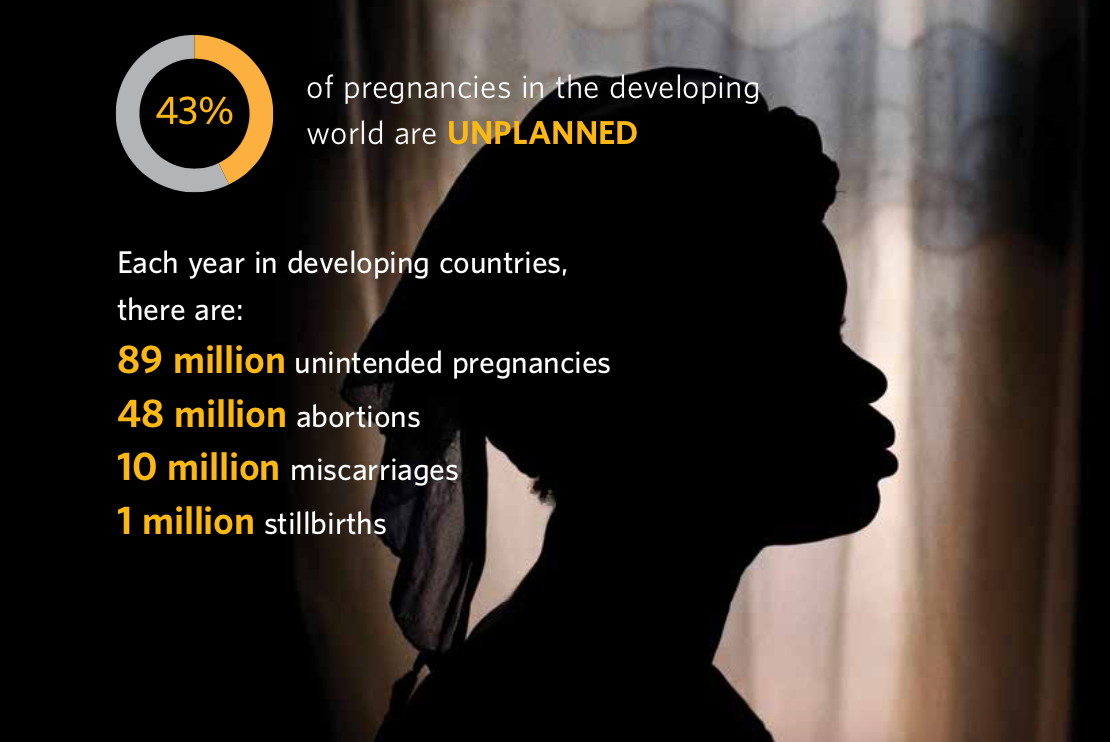Pots, Kettles, and Unintended Pregnancies
When the United Nations Population Fund released its flagship report “State of World Population” last fall, my attention was drawn to one particular page:

The words “43% of pregnancies in the developing world are UNPLANNED” are superimposed on the image of a woman in a dark room, her features in silhouette against a dimly lit window—the sort of output you might get if you typed the word “somber” into Google Image Search.
Clearly, this presentation is meant to create the impression that this a big problem, and one requiring a big push for a solution. But the discerning reader would want more context: how does this compare to previous years – are we doing better or worse? How does this compare to the developed world? Such readers looking for answers in UNFPA’s artful coffee table book would find themselves disappointed. Picture of a smiling woman sipping a cocktail on a terrace all by herself? Check. Picture of sober-faced women surrounded by offspring? Check. Percentage of pregnancies UNPLANNED in the developed world? Goose egg.
But at last we have answers—and what answers we have. Published by the Lancet, written by the Guttmacher Institute, and funded by the governments of the UK and the Netherlands, the latest figures on global unintended pregnancy have arrived.
It’s important to note that there are different ways to define unintended/unplanned/unwanted/mistimed pregnancy – the Guttmacher Institute once hilariously published a lengthy description of the nuances of each definition (see my discussion here), and finished with the statement that “[a]ll of these definitions assume that pregnancy is a conscious decision.”
But setting aside how exactly a pregnancy gets classified as “unintended,” there are also multiple ways to present the incidence with which this occurs. One way is the unintended pregnancy rate, expressed as the number of unintended pregnancies per 1,000 women of reproductive age per unit time. Another way is to calculate the percentage of all pregnancies that are classified as unintended.
The most obvious difference between these two methods is that the former is heavily influenced by total fertility levels, while the latter is not. And, as it turns out, when you use these measurements to compare between global regions, that matters a lot.
Regarding the unintended pregnancy rate, when we compare the Guttmacher data on developed vs. developing regions over time, we see this:

And when we compare the percentage of pregnancies classified as unintended, we see this:

So much depends on what measurement you use. And, given what we know about the policy agenda being pushed by the parties involved in publishing this paper, it should come as no surprise that the data on unintended pregnancy rates (where developed regions appear to be performing better) was prominently featured in the body of the main paper, while the data on the percentage of pregnancies unintended (where developing regions have the upper hand) was consigned to the supplemental data package, in very small print.
But publish it they did, even if you have to look twice as hard to find it. And at last, we can solve the riddle posed by the UNFPA’s annual report: if 43% of pregnancies in the developing world are unplanned, so are 46% of pregnancies in the developed world. Pot, meet kettle.
In fact, the region with the lowest percentage of pregnancies unintended is Africa: 39%. Yes, their fertility is the highest, but a higher percentage of that fertility is intended, compared with the rest of the world. Makes you wonder why the big donors aren’t going to Africa looking for best practices to share, rather than pushing them to use more contraceptives.
Is this a big problem requiring big solutions? Perhaps the better question is this: if the wealthiest countries in the world haven’t managed to eradicate the pesky link between sex and pregnancy, or turn that basic biological principle from an opt-out to an opt-in, why should we expect better from lower-resource countries? Maybe a better starting point would be to recognize that, with exceptions, sex tends to produce babies, and modify our attitudes toward sex accordingly. And maybe we should change the somber tone of that UNFPA report and replace it with something a bit more optimistic, with a photo from UNFPA and data courtesy of the Guttmacher Institute:

Because context is important, right?
View online at: https://c-fam.org/turtle_bay/pots-kettles-unintended-pregnancies/
© 2025 C-Fam (Center for Family & Human Rights).
Permission granted for unlimited use. Credit required.
www.c-fam.org

